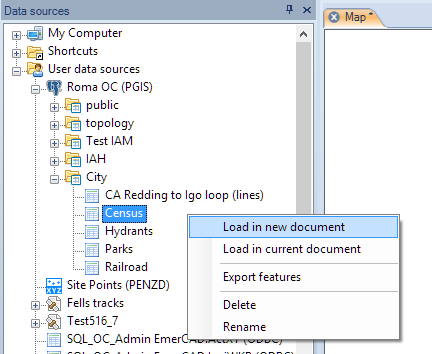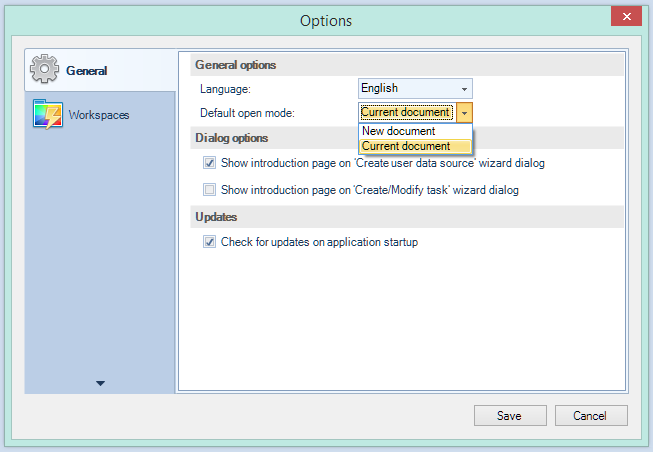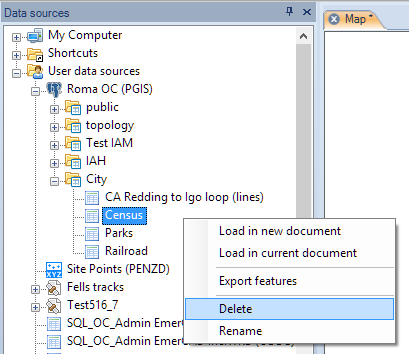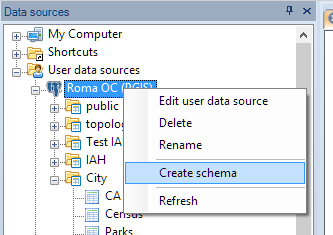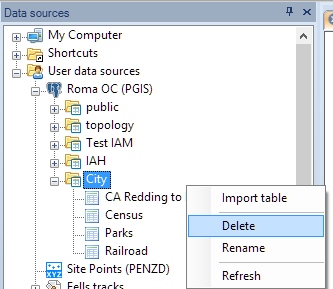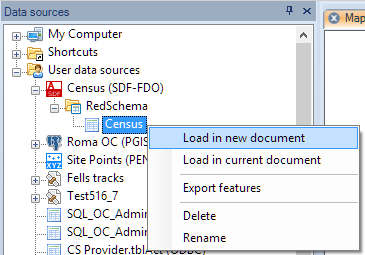Difference between revisions of "Spatial Manager™ for AutoCAD - FAQs: Databases"
m |
|||
| Line 9: | Line 9: | ||
| − | ===How can I load a data Table from a spatial database or data store into a Map in Spatial | + | ===How can I load a data Table from a spatial database or data store into a Map in Spatial Manager™ for AutoCAD?=== |
| − | To access spatial databases or data stores you need first to have defined a User Data Source (UDS) including all the parameters to connect with (to learn more about UDSs, see: [[Spatial | + | To access spatial databases or data stores you need first to have defined a User Data Source (UDS) including all the parameters to connect with (to learn more about UDSs, see: [[Spatial Manager™ for AutoCAD - FAQs: Data sources| Data sources page]]) |
You can load a data Table from a spatial database or data store using the right-click menu over the Table item itself inside a container of the UDS (usually a Schema), in the "Data sources" panel, to load its content into a new or existing Map. You can also double-click over the Table item itself, in the "Data sources" panel, to load its content into a new or existing Map (this behaviour may be configured in the application settings) | You can load a data Table from a spatial database or data store using the right-click menu over the Table item itself inside a container of the UDS (usually a Schema), in the "Data sources" panel, to load its content into a new or existing Map. You can also double-click over the Table item itself, in the "Data sources" panel, to load its content into a new or existing Map (this behaviour may be configured in the application settings) | ||
Revision as of 14:24, 26 February 2014
Introduction
- Objective of this section
- To access spatial information tables included in spatial databases
- Topics in this section
- Accessing spatial databases: UDSs definition using connection and setting parameters
- Schemas and classes: structures of tables contained in databases
How can I load a data Table from a spatial database or data store into a Map in Spatial Manager™ for AutoCAD?
To access spatial databases or data stores you need first to have defined a User Data Source (UDS) including all the parameters to connect with (to learn more about UDSs, see: Data sources page)
You can load a data Table from a spatial database or data store using the right-click menu over the Table item itself inside a container of the UDS (usually a Schema), in the "Data sources" panel, to load its content into a new or existing Map. You can also double-click over the Table item itself, in the "Data sources" panel, to load its content into a new or existing Map (this behaviour may be configured in the application settings)
Are there any other functions for the Tables in Spatial Manager Desktop™?
Yes, you can Delete or Rename the Tables in Spatial Manager Desktop™ using the right-click menu over the Table item itself. This is valid for Tables in spatial databases but not for Tables in data stores
How can I create a Schema in a spatial database in Spatial Manager Desktop™?
You can create a Schema in a spatial database in Spatial Manager Desktop™ using the right-click menu over the UDS. When creating, you can assign a name to the New Schema
Are there any other functions for the Schemas in Spatial Manager Desktop™?
Yes, you can Delete or Rename the Schemas and Refresh the Schema contents in Spatial Manager Desktop™ using the right-click menu over the Schema item itself. Be careful when you Delete a Schema because all the Tables that it contains will also be deleted. This is valid for Schemas in spatial databases but not for Schemas in data stores
Are there any other kind of data sources using Schemas or Tables in Spatial Manager Desktop™?
Yes, you can find some Providers using Schemas or Tables in Spatial Manager Desktop™, besides spatial databases or data stores, like some type of files, such as SDF and more, or special connections, such as ODBC and more. Everything said here for Schemas and Tables is valid for these types of data sources
